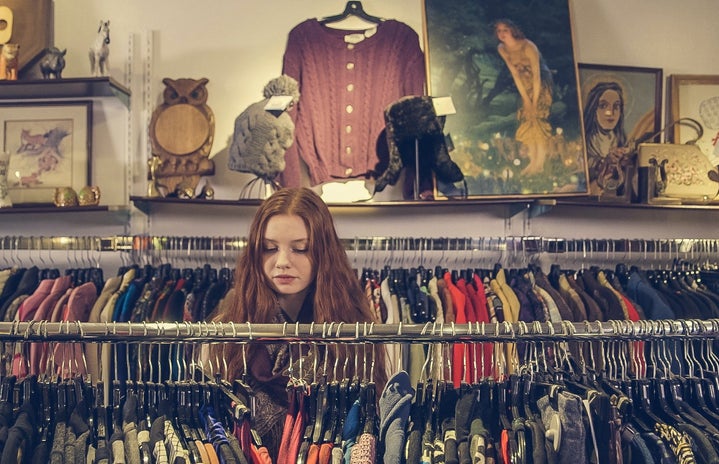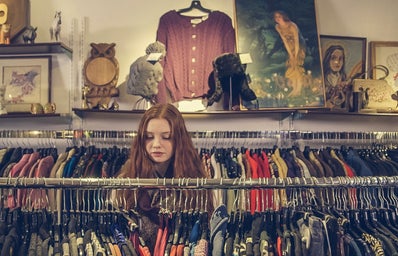According to the New York Times, conscious consumption is an umbrella term that simply means engaging in the economy with more awareness of how your consumption impacts society at large. In other words, it is about knowing that everything you buy is somehow going back to where it came from: the planet and its sources. We can also say that it is related to being more mindful of the kinds of products we buy and the kinds of brands we support.
But before we start talking about conscious consumption, we have to take a step back and talk about responsible and sustainable production. Which goes in the opposite direction of the famous fast fashion industry.
The “throwaway fashion”
Fast fashion is a manufacturing method focused on the rapid production of high volumes of clothing. Basically, it allows consumers to buy trendy pieces at really small prices and poor quality that they will probably not use for a long time. The industry has to keep up with the “global appetite for newness”, so they release approximately 52 mini collections per year, which is 26 for each month. Of course, with this extremely fast rhythm the production is not valued and neither is the environmental impact or the working conditions of their employees.
A report by the Ellen MacArthur Foundation found out that people are buying 60% more clothes than 15 years ago, but wearing them for half as long. From that we can infer that it is directly related not just to the new consumer society, but also to the fabric quality and the increased use of synthetic materials, which has almost doubled in the last 20 years. The synthetic fibers used in the fast fashion industry, such as polyester, are made using fossil fuels, and according to the same report, “greenhouse gas emissions from textiles production totaled 1.2 billion tonnes of CO2 equivalent, more than those of all international flights and maritime shipping combined.” These fibers do not biodegrade and remain in the environment forever.
This “throwaway fashion” is based on what we call “take-make-waste”. We take from our environment, we make it with very little regard for those who produce it because the clothes have so little value and with the blink of an eye, they are in the trash. According to the Council for Textile Recycling, the average US citizen throws away 70 pounds of clothing and other textiles annually, and 87% of the total is either incinerated, landfilled, or dumped into nature. The textile industry is clearly an unsustainable model, we pay low prices now, but the high ones are coming from the Earth.
The I-have-nothing-to-wear anxiety
Besides allowing consumers to buy more, the fast fashion industry also incentives it and creates an enormous consumer society. Cheap clothes keep consumers turning to each new style.
According to The Business of Fashion Sustainability Index, which measures brands’ actions to reduce their impact, some luxury brands are behind fast fashion ones in initiatives and numbers. The differences beyond them are related to consumption.
Izabela Castro and Sarah Rabello, owners of the Instagram page @devagarzin that help followers to understand this industry and to be more conscious about it, said: “Fast fashion has a lot of negative impacts, but the most relevant one involves an exacerbated, accelerated, and not necessary consumption, which has ambiental and social damages. As they need to sell in huge quantities, it incentivizes cheap labor, affecting the social and, of course, the environmental impact with the discharging of residues and with its production.”
The massive marketing campaigns create an image that if you don’t buy certain clothing now, it will not be available later as if you needed this more than ever. We’re constantly being bombarded by fast fashion advertisements telling us that what we have is not good enough, that we need more, and that is extremely problematic, causing “I-have-nothing-to-wear anxiety” that can lead to shopping dependency. An increasing number of people, especially Gen Z women, see shopping as an accessible way to cope with their feelings, and the cheap and approachable clothing the industry makes is encouraging it.
The polemic and controversial fast fashion company Shein, which went viral in 2020 for trendy styles and really low prices, claims to post over 1000 new styles a day. Shein’s hauls are all over the internet, and people don’t seem to care about the real quality of their clothes because of their prices and variety. Fashion Revolution says that “cheap prices make us believe they bring savings for consumers. This may appear true in the short term, with a narrow focus and looking just at the money in our wallets, but all of us, as global citizens, will eventually end up pay the external cost, the true cost for the unsustainable consumption and production of cheap clothing”, and they proceed “this is why, when garments are priced as cheaply as single-use items, it implies that our clothing is disposable. And if we buy that message, we are buying into a very ugly side of fashion.”
Castro and Rabello also added that it is difficult to reduce this anxiety: “It is a process, the more we learn about fashion, the more we understand that trends take part of human culture in the search for identification, but we have some solutions for that: first, customization. That always relieves us. You can always see that being different is the coolest! Furthermore, we have the 5-day-rule: before buying something by impulse, wait 5 days, let the idea mature, and in the end, if you still want that piece, respect your wishes! And at least, if you really identify yourself with some trend, understand that it’s okay to be part of it. We preach conscious consumption but that doesn’t mean abdicate for your shopping forever.”
A women’s rights issue
Almost a decade after the Bangladesh Rana Plaza factory collapse which killed 1,138 garment workers at Dhaka, these workers are still not in good conditions, they are still underpaid, exploited and abused. The employees usually work with no ventilation, breathing in toxic substances in unsafe buildings. Many cases of forced labour have also been reported along the fashion chain, including the frequent use of forced child labour. In these situations, workers’ rights are nonexistent and production sites regularly move to seek for ever-cheaper labour. So even if one country improves its situation, thousands of people will be unemployed because the factories will move to another.
These companies are exploiting misery and taking advantage of poor populations who have no choice but to work for any salary. When some factories claim that they are at least paying the legal minimum wage, it means that some of them are still not doing so. The average minimum wage at manufacturing countries is about $100 and, as The Clean Clothes Campaign states, the living wage is almost five times that, which is very problematic because the government does not give their population what is necessary to live with dignity – they are on the capitalist side, not the human side. In addition, UN warned that during the pandemic the contemporary slavery has increased with false job promises and debt bondage.
According to the documentary The True Cost, 85% of garment workers are young women aged 18-24. They earn less than $3 a day, and for each day of work, they are given an incredibly high quantity of garments to fulfill per hour, and not reaching the necessary number means not getting paid at all. A study realized by Global Fund for Women shows that in Cambodia, 68% of women clothing workers said that they were made to feel uncomfortable or unsafe at work, and in Vietnam, 34% said they experienced physical harassment such as kissing, touching, or hitting. So in fact, those women are experiencing contemporary slavery. The fast-fashion problem is also a women’s rights issue.
“We believe in the power of the consumers’ voices, after all, they can change positionings. These voices need to be used to demand, not only from the label but also from regulatory agencies and local governments (…) it is important not to consume these brands so you don’t become part of it. If you can, choose a local producer or little entrepreneur” says the girls from @devagarzin.
Structure problems
Although women control over twenty trillion dollars in consumer spending every year, which is massive consumer power, the 2017 Global Fashion Agenda showed that regulatory agencies and public policies are the most powerful influencers on sustainability inside companies, staying ahead of boycotting or other similar approaches. We can say that the lack of public awareness and government regulations is what makes this a really unsolvable question.
We, as a society, tend to ignore structure problems and individualize solutions and responsibilities when we talk about socio-environmental issues. While we keep talking about them, governments are making geopolitical agreements to enlarge production and consumerism. The problem lies beyond this unstoppable consumption, although being conscious about it is a great way to start on a personal level.
Sabrina Fernandes, author of the 2020 book “Se quiser mudar o mundo” (“If you want to change the world”), says that “as we change our ways of consuming, production adapts to the new market demands. Production as a whole doesn’t start to be sustainable as the market starts asking for it. They just create a ‘green’ production niche, as long as it is attached to the profit”. To exemplify, the fast-fashion giant H&M has created a collection called “Sustainable Style”, which says that at least 50% of each piece is made from more sustainable materials. But that’s the only thing they declared, they didn’t give any more details about the production. Also, the marketing campaign is full of green images, models around nature. To be honest, every part of the collection is clumsy, they are clearly doing this without any real concern.
What can I do?
It’s a nice choice to buy exclusively from ethical brands, or what we call slow fashion. But that simply is not an option for most people. Talking about boycotting these fast fashion brands is also a controversial point when almost 75 million people work making clothes and they are the most accessible in the market when it comes to diversity of sizes. Therefore, what can we do?
Izabella Castro and Sarah Rabello, when asked about it, suggested: “we indicate that you always demand transparency from the label you consume. Search for its background, talk about it, get informed. There are differences between those fast fashion brands, they are not all the same! It is always very important to buy consciously, reviewing if you really need it all, not letting the storefront window seduce you just because it was cheap. We still have a long way to go but some fast fashion brands are working on interesting actions to reduce impacts.”
————————————————————————-
The article above was edited by Giulia Lozano Pacini.
Like this type of content? Check Her Campus Casper Libero home page for more!


